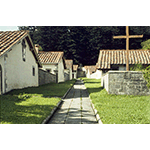Antica Farmacia del Monastero di Camaldoli [Ancient Pharmacy of the Camaldoli Monastery]
The pharmacy, situated within the Camaldoli Monastery, dates from 1513, the year in which it was rebuilt after a devastating fire in 1504. However, its year of foundation appears to be much earlier than its date of reconstruction. The first document concerning the Hospital and the annexed Pharmacy of Camaldoli, both destroyed in 1276 and rebuilt for the first time in 1331, dates in fact from May 1048. The pharmacy flourished during the course of 17th and 18th centuries, but in 1866, subsequent to the law suppressing the monasteries promulgated by the Italian government, its activity ceased. Another consequence of the law was the dismembering of the Monastery's library. The precious manuscripts, among them several Greek and Latin codexes and numerous scrolls, were transferred to the Biblioteca Medicea Laurenziana in Florence and the Library of Arezzo, while the printed books were consigned to the Rilliana Library in Poppi.
The pharmacy, which conserves intact its furnishings and some of its pharmaceutical equipment, is divided into two sections: the sales area and the Galenic laboratory. The wooden entrance door to the sales area is decorated with symmetric plaques with inlaid chalices and doves, symbols of the Camaldoli community. The wooden shelves in the sales area date from the time of the pharmacy's foundation. On the chest of drawers, near the ceiling, are ovals portraying Cosmos and Damian, the patron saints of pharmacists. The pharmaceutical equipment is more recent, although a substantial number of glass and ceramic instruments and a good collection of copper tableware are found in the laboratory. In 1867 the more precious glass objects were loaned to the Museo Statale d'Arte Medievale e Moderna in Arezzo, where they are still displayed today.
The pharmacy has now begun again to produce some of its specialties, for the most part aromatic substances and liqueurs.
****************************
Texts by Graziano Magrini
English translation by Catherine Frost
Last update 18/mar/2008




